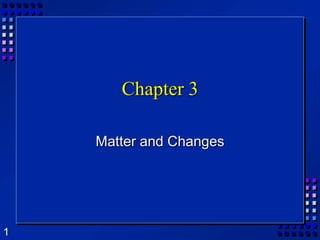
Chapter 3 Matter Properties And Changes
- 1. Chapter 3 Matter and Changes
- 2. Properties of Matter (3.1) Matter is anything that takes up space and has mass. Mass is the amount of matter in an object.
- 3. Types of Matter Pure Substance: Matter that has a uniform composition (H2O) Can’t be separated by physical means Mixture: Physical blend of 2 or more pure substances (Salt water). Can be separated by physical means (filter, evaporate, distillation, crystallize).
- 4. Properties of Matter Physical Properties: Can be observed and measured without changing the substance. Ex. Density, color, odor, taste, hardness, melting point, boiling point. Chemical Properties: Ability of a substance to combine with or change into one or more substances. Examples: flammability, heat of combustion, reactivity with water, pH.
- 5. Properties of Matter Extensive Properties- A property that changes when the size of the sample changes. Ex. Mass, length, volume Intensive Properties- A property that doesn't change when you take away some of the sample. Ex. temperature, color, hardness, melting point, boiling point, pressure, molecular weight, and density. Used to identify a substance
- 6. States of matter Solid- matter has definite shape and volume. Liquid- definite volume but takes the shape of its container (flows). Gas- a substance without definite volume or shape and can flow to fill its container. Vapor- a gas, but normally is a liquid or solid at room temperature. Plasma High temperature ionized gas Most common in the universe
- 7. States of Matter Definite Volume? Definite Shape? Temp. increase Com-pressible? Small Expans. Solid YES YES NO Small Expans. Liquid NO NO YES Large Expans. Gas NO NO YES
- 8. Condense Freeze Evaporate Melt Gas Liquid Solid
- 9. Changes in Matter (3.2) Physical changes - a change that changes appearances, without changing the composition. Examples? Melting Ice, Bend a spoon, Chemical changes - a change where a new form of matter is formed. Also called chemical reaction. Examples? rusting, explode, burn, rot, tarnish Not phase changes! Ice is still water.
- 10. Conservation of Mass Mass can not be created or destroyed in ordinary (not nuclear) changes. All the mass can be accounted for. Mass at the start (Reactants) = mass at end (Products)
- 12. Mixtures of Matter (3.3) Mixtures are made up of two substances. Variable composition. Mixtures can be: Heterogeneous- mixture is not the same from place to place. (Chocolate chip cookie, gravel, soil). Or, Homogeneous- same composition throughout. (Kool-aid, air). Every part keeps its properties. A Homogeneous mixture is also referred to as Solution.
- 13. Separating mixtures Only a physical change- no new matter Filtration- separate solids from liquids with a barrier
- 14. Separating mixtures Distillation- separate because of different boiling points Heat mixture Catch vapor in cooled area
- 15. Separating mixtures Chromatography- different substances are attracted to paper or gel, so move at different speeds.
- 16. Separating mixtures (cont.) Crystallization- Separation technique that results in the formation of pure solid. (ex. Making rock candy).
- 17. Elements and Compounds (3.4) Elements- simplest form of matter Can’t be broken down into simpler substances Made-up of identical atoms (Ex. Na, Fe) Compounds are combinations of two or more elements (ex. NaCl). can be broken down by chemical methods When they are broken down, the pieces have completely different properties than the compound. (Salt vs. Na or Cl) Made of molecules- two or more atoms stuck together (H2O)
- 18. Compound or Mixture Compound Mixture One kind of piece- Molecules or formula units More than one kind - Molecule or atoms Making is a chemical change Making is a physical change Only one kind Variable composition
- 19. Which is it? Element Compound Mixture
- 20. Chemical Reactions Another name for chemical change When one or more substances are changed into new substances. Reactants- stuff you start with Products- What you make NEW PROPERTIES
- 21. Indications of a chemical reaction Energy absorbed or released Color change Odor change Precipitate- solid that separates from solution Not easily reversed
- 22. Chemical symbols There are 118 elements (He, Fe, etc.) Each has a 1 or two letter symbol First letter always capitalized, second never (Pb)
- 23. Chemical symbols Used to write chemical formulas Subscripts tell us how many of each atom H2O C3H8 HBrO3
- 24. Energy The ability to do work. Work - cause a change or move an object. Many types- all can be changed into the other.
- 25. Types of energy Potential- stored energy Kinetic Energy- energy something has because its moving Heat- the energy that moves because of a temperature difference. Chemical energy- energy released or absorbed in a chemical change. Electrical energy - energy of moving charges
- 26. Types of Energy Radiant Energy- energy that can travel through empty space (light, UV, infrared, radio) Nuclear Energy – Energy from changing the nucleus of atoms All types of energy can be converted into others. If you trace the source far enough back, you will end up at nuclear energy.
- 27. Conservation of Energy Energy can be neither created or destroyed in ordinary changes (not nuclear), it can only change form. Its not just a good idea, its the law.
- 28. What about nuclear? E = mc2 energy = mass x (speed of light)2 speed of light = 3 x 108 A little mass can make a lot of energy Law of Conservation of Mass - Energy the total of the mass and energy remains the same in any change